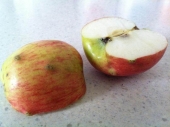
 4
4




 3
3




My impression is that I need to wait longer until bottling. Does that sound right?
"Study books and observe nature; if they do not agree, throw away the books." ~ William A. Albrecht
 3
3




 1
1




A piece of land is worth as much as the person farming it.
-Le Livre du Colon, 1902
 2
2












Invasive plants are Earth's way of insisting we notice her medicines. Stephen Herrod Buhner
Everyone learns what works by learning what doesn't work. Stephen Herrod Buhner





 1
1




Matheson Russell wrote:I'm brewing ginger beer following the Art of Fermentation and am this close to wild success. The only problem is that it won't carbonate right; opening the bottle gets a nice fooomp noise, but no fizz in the drink. So there's obviously carbon dioxide there, but...
I make the ginger bug with 1tbsp each of ginger and sugar. I boil up the ginger/sugar decoction just as the instructions suggest, waiting for it to cool until body temperature or cooler before adding the ginger bug. I wait a few days until it starts to fizz and bottle, letting sit a few days more to carbonate, then refrigerate.
Possible points of failure: I stir the mixture during the days it ferments before bottling. I thought that might knock the floating ginger bits back in and help it ferment, but maybe it's knocking carbon dioxide out? My carboy bottles are hand-me-downs - the seal could be imperfect. For people who've done this before, am I waiting too long to bottle and missing peak fermentation? I thought I did that once and might be bottling too soon.
Weirdly, the first time I did this, it fizzed appropriately (so the bottles probably aren't the problem). I'm on the fourth batch, each time trying to get more fizz, but have gotten none at all. This past batch was an attempt to do everything exactly the way I did it the first, most successful time, and nothing. I took notes and the first time, when things carbonated, the ginger beer only had to sit one day on the counter and was fizzy. This past time, I waited five days and only got the foomp.
My impression is that I need to wait longer until bottling. Does that sound right?
 2
2




 2
2




Cade Johnson wrote:it sounds like the fermentation is working, so carbon dioxide is being produced. The "secret" to high carbonation is pressure. The higher the pressure, the more CO2 dissolves. A larger container will need much higher strength to handle high pressure than a small container. If you can reuse 2L PET bottles (or smaller), they have very high pressure capacity and will give much safer pressurization than a large glass carboy. A large plastic carboy will likely just expand to accommodate the CO2, rather than rise in pressure.
Within a fermented liquid under pressure, shaking or stirring will not have an effect on the amount of CO2 in solution because the solution is already at equilibrium. However, it can entrain small bubbles into the liquid which serve as nucleation sites. So if you release the pressure after shaking, you get more spray. This is the basis of the Penn & Teller skit for transferring energy from one can to another: give the victim an unopened soft drink and invite them to shake it as hard as they like. Then set the can down on a table beside a second soft drink. While the cans are side-by-side, make magical gestures to summon the energy from one can and put it into the other (taking at least 30 seconds for the show to let fine bubbles leave the liquid). Then invite them to open that can. It will "pop" but not overflow because it has re-equilibrated. Pick up the "energized can" and with a firm grip on the can (actually squeezing it in a little if possible to over-pressurize it), open it in the victim's direction - worked better with the old pull tab style which was replaced specifically to foil this trick after it was played on softdrink executives - and with practice you can expel about half the can of softdrink onto the victim.
 3
3




 2
2




Cade Johnson wrote:Sebastian, since the preparation of the nutrient portion of ginger bug is pretty straightforward, the problem probably lies with the fermentation organisms - are you using a "starter" colony or perhaps preserved yeast? You might be able to test your starter bug briefly before mixing into the bottles by some variation on common methods for testing dry yeast. Although ginger bug starter is accustomed to different conditions than, say, sourdough starter - you could make a comparably aligned test solution like, maybe a small amount of warm 5% sugar solution - too much sugar could kill the fermenters, and too little could make it hard to see activity quickly. Too high or low temperature could also be a problem - but somewhere around 100F/35C .
 2
2




 2
2





 5
5




Proudly presenting RocketMassHeaters.com
A good starting point to all RMH research
How Permies.com works
 4
4




“The most important decision we make is whether we believe we live in a friendly or hostile universe.”― Albert Einstein
 7
7




John Weiland wrote:Are most others here using some source of 'controlled' water quality like distilled or bottled drinking water to start their ferments?

|
The world's cheapest jedi mind trick: "Aw c'mon, why not read this tiny ad?"
The new purple deck of permaculture playing cards
https://www.kickstarter.com/projects/paulwheaton/garden-cards
|





